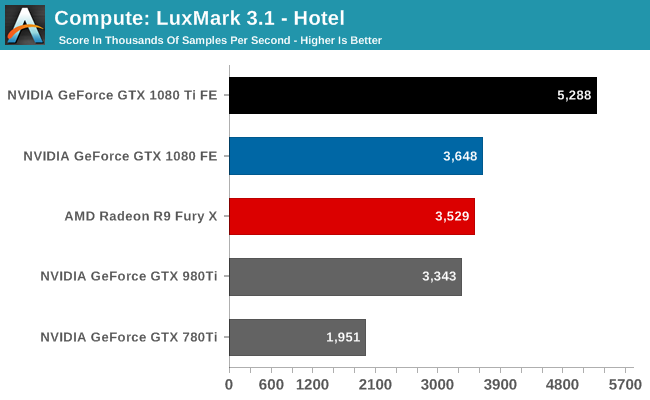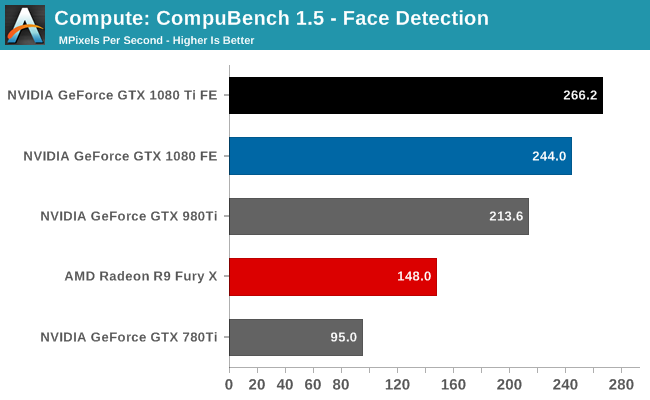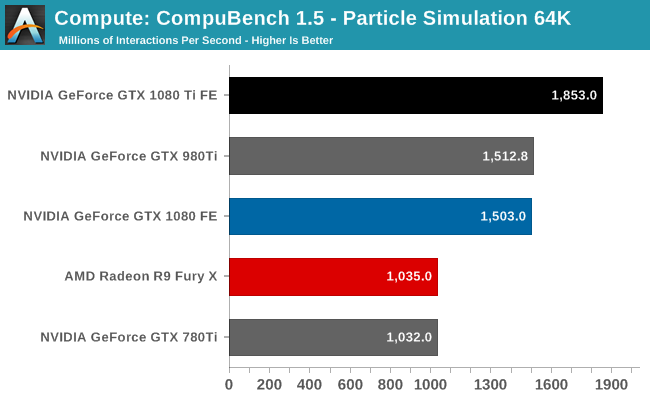The NVIDIA GeForce GTX 1080 Ti Founder's Edition Review: Bigger Pascal for Better Performance
by Ryan Smith on March 9, 2017 9:00 AM ESTCompute
Shifting gears, let’s take a look at compute performance on GTX 1080 Ti.
Starting us off for our look at compute is LuxMark3.1, the latest version of the official benchmark of LuxRender. LuxRender’s GPU-accelerated rendering mode is an OpenCL based ray tracer that forms a part of the larger LuxRender suite. Ray tracing has become a stronghold for GPUs in recent years as ray tracing maps well to GPU pipelines, allowing artists to render scenes much more quickly than with CPUs alone.

The OpenCL situation for NVIDIA right now is a bit weird. The company is in the middle of rolling out OpenCL 2.0 support to their video cards – something that I had actually given up hope on until it happened – and as a result their OpenCL drivers are in a state of flux as company continues to refine their updated driver. The end result is that OpenCL performance has dipped a bit compared to where the GTX 1080 launched at back in May, with said card dropping from 4138 points to 3648 points. Not that the GTX 1080 Ti is too fazed, mind you – it’s still king of the hill by a good degree – but the point is that once NVIDIA gets their drivers sorted out, there’s every reason to believe that NVIDIA can improve their OpenCL performance.
For our second set of compute benchmarks we have CompuBench 1.5, the successor to CLBenchmark. CompuBench offers a wide array of different practical compute workloads, and we’ve decided to focus on face detection, optical flow modeling, and particle simulations.



Like LuxMark, CompuBench shows some minor performance regressions on the GTX 1080 as compared to the card’s launch. None the less, this doesn’t do anything to impede the GTX 1080 Ti’s status as the fastest of the GeForce cards. It dominates every sub-benchmark, including Optical Flow, where the original GTX 1080 was unable to pull away from AMD’s last-generation Radeon R9 Fury X.










161 Comments
View All Comments
webdoctors - Thursday, March 9, 2017 - link
No, its because the dollar is worthless and real inflation is off the charts. Once we make the dollar great again, we'll see prices come down.eddman - Thursday, March 9, 2017 - link
The only reason that we had $500 cards is because of the fierce competition from ATI back then.Whenever ATI's cards couldn't compete, or could but were not launched yet, nvidia jacked the prices up. I don't know why people forget the $600 8800 GTX or $650 GTX 280. Take a look at the link I posted above.
mapesdhs - Saturday, March 11, 2017 - link
What I miss is being able to buy a couple of well-priced mid-range cards that beat the high-end, with good scaling. I couldn't afford the 580 when it was new, but 2x 460 SLI was faster and served nicely for a good while. With support & optimisations moving away from SLI/CF though (lesser gains, more stuttering, costly connectors, unlock codes, etc.), a single good GPU is more attractive, but the cost way up the scale compared to 5 years ago.Have a look at the Anand review for the 280 though, it shows what I mean: 2x 8800GT SLI was faster than the 280, but $200 cheaper and with excellent scaling. I had 2x 8800GT 1GB before switching to the two 460s. Today, mid-range cards don't even support SLI (GTX 1060).
Ian.
Meteor2 - Tuesday, March 14, 2017 - link
What about two RX480s? Can they top a 1080?aryonoco - Thursday, March 9, 2017 - link
The 780 Ti was released in November 2013.The 1080 Ti is being released now, in March 2017.
So 3.5 years later, Nvidia's flagship consumer card has improved 260% while using pretty much the same amount of power and generating pretty much the same level of noise.
If this continues, I can see that in the next few years, all sort of software will find a way to utilise the GPU more, not just games and neural networks.
Nvidia has a lot to be proud of. Their execution in the past few years has been Apple-esque.
Meteor2 - Friday, March 10, 2017 - link
Reflected in their share price!virtuastro - Thursday, March 9, 2017 - link
@Ryan SmithCan you test Intel i7 7700K, Intel-E Processors, and Ryzen 7 1800x with a GTX 1080ti in benchmark? :)
Ryan Smith - Thursday, March 9, 2017 - link
Unfortunately no. We don't have a central office; I'm in the US with the GPUs, and Ian is in the UK with the CPUs. He's working on game testing for Ryzen Part 2, but we likely won't be able to include the GTX 1080 Ti.virtuastro - Thursday, March 9, 2017 - link
Aw dang. Thanks for answer anyway. :DMeteor2 - Friday, March 10, 2017 - link
FedEx?